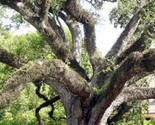Package of 10 seed. Quercus virginiana (Live Oak)
Perfect for bonsai.
Quercus virginiana
Depending
on the growing conditions, live oaks vary from the shrubby to large and
spreading: typical open-grown trees reach 15 meters (50 feet) in
height, but may span nearly 50 meters. Their lower limbs often sweep
down towards the ground before curving up again. They can grow at severe
angles, and Native Americans used to bend saplings over so that they
would grow at extreme angles, to serve as trail markers. They drop their
leaves, and grow new ones, within a few weeks in spring. The bark is
furrowed longitudinally, and the acorns are small, but long and tapered.
The branches frequently support other plant species such as rounded
clumps of ball moss, thick drapings of Spanish moss, Resurrection fern,
and parasitic mistletoe.
Southern live oak can grow in moist to
dry sites. They can withstand occasional floods and hurricanes, and are
resistant to salt spray and moderate soil salinity. They tend to survive
fire, because often a fire will not reach their crowns. Even if a tree
is burned, its crowns and roots usually survive the fire and sprout
vigorously. Furthermore live oak forests discourage entry of fire from
adjacent communities because they provide dense cover that discourages
the growth of a flammable understory. Although they grow best in
well-drained sandy soils and loams, they will also grow in clay. Live
oaks are also surprisingly hardy. Those of southern provenance can
easily be grown in USDA zone 7 and the Texas Live Oak (Quercus
virginiana var. fusiformis), having the same evergreen foliage as the
Southern variety, can be grown with success in areas as cold as zone 6.
Even with significant winter leaf burn, these trees can make a strong
comeback during the growing season in more northerly areas such New
Jersey, southern Ohio, and southern Connecticut.
Among
the animals for which live oak acorns are an important food source are
the bobwhite quail, the threatened Florida scrub jay, the wood duck,
yellow-bellied sapsucker, wild turkey, black bear, various species of
squirrel, and the white-tailed deer. The tree crown is very dense,
making it valuable for shade, and the species provides nest sites for
many other species.
Live oak wood is hard, heavy, and difficult to
work, but very strong. In the days of wooden ships, live oaks were the
preferred source of the framework timbers of the ship, using the natural
trunk and branch angles for their strength. The frame of USS Constitution
was constructed from Southern live oak wood harvested from St. Simons
Island, Georgia, and the density of the wood grain allowed it to survive
cannonade, thus earning it the nickname "Old Ironsides". Even today the
U.S. Navy owns extensive live oak tracts. Several live oaks are notable
landmarks, including two named the "Treaty Oak;" one in Texas and
another in Florida. Native Americans extracted an oil from the acorns.
Care
for the Southern live oak is very easy, as it requires very little
watering while it is young. After it is 4 to 5 feet tall, watering can
be forgotten, and no more care is required. Southern live oak is
long-lived. Trees in excess of 500 years were once common, and one, the
Angel Oak on Johns Island, South Carolina is estimated at 1400 years of
age; it is 20 m tall, 2.47 m diameter, and with a maximum spread
(longest branch) of 27 m; the crown covers an area of 1,580 m2.
Live oak or evergreen oak is a general term for a number of unrelated oaks in several different sections of the genus Quercus that happen to share the characteristic of evergreen foliage.
The name live oak
comes from the fact that evergreen oaks remain green and "live"
throughout winter, when other oaks are dormant, leafless and
"dead"-looking. The name is used mainly in North America, where
evergreen oaks are widespread in warmer areas, along the Atlantic coast
from southeast Virginia and North Carolina to Florida, west along the
Gulf Coast to Texas and across the southwest to California and southwest
Oregon. In particular, the campus of Rice University is home to
thousands of live oaks.
Evergreen oak species are also common in
the warmer parts of Europe and Asia, and are included in this list for
the sake of completeness. These species, although not having "live" in
their common names in their countries of origin, are colloquially called
live oaks when cultivated in North America.
When the term live
oak is used in a specific rather than general sense, it most commonly
refers to the Southern live oak (the first species so named), but can
often refer to other species regionally.
The live oak is the official state tree of Georgia.
This
rounded, deciduous tree eventually has widespreading branches which are
green when young and covered with spines, often becoming grey and
sometimes losing their coarse, sharp spines, Young trees can have a
columnar or upright form. The spiny trunk is unusually thick and remains
green even on older trees. Floss-Silk tree grows rapidly the first few
years, then more slowly. Some trees maintain a relatively narrow crown
with one straight trunk while others are wide-spreading, particularly on
older specimens. The large, showy, pink and white, five-petaled
flowers, which somewhat resemble narrow-petaled hibiscus, are produced
in small clusters in fall and winter (usually October) when the tree is
nearly bare. The fruits are large, eight-inch-long, pear-shaped, woody
capsules, filled with silky, white, kapok-like floss and pea-like seeds. Floss from the seeds was used for stuffing pillows and thin strips of the bark have been used to make rope.
PACKAGE OF 10 SEEDS, the
seeds were took this season, We have a lot of extremely rare plants if
you want something rare let me know and I will listing for you.
Questions? feel free to email me.
